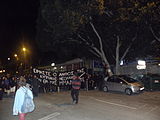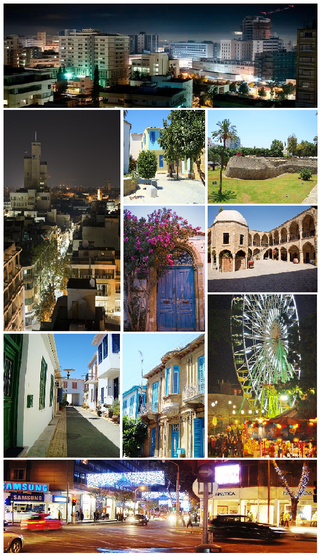
Nicosia is the capital and largest city of Cyprus. It is located near the centre of the Mesaoria plain, on the banks of the River Pedieos.

The Cyprus problem, also known as the Cyprus conflict, Cyprus issue, Cyprus dispute, or Cyprus question, is an ongoing dispute between the internationally-recognised Republic of Cyprus of the Greek Cypriot community in the southern portion of Cyprus, and that of the Turkish Cypriot community, situated in the occupied north.

The United Nations Buffer Zone in Cyprus is a demilitarized zone, patrolled by the United Nations Peacekeeping Force in Cyprus (UNFICYP), that was established in 1964 and extended in 1974 after the ceasefire of 16 August 1974, following the Turkish invasion of Cyprus, and the de facto partition of the island into the area controlled by the Republic of Cyprus and the largely unrecognized Turkish Republic of Northern Cyprus in the north. The zone, also known as the Green Line, stretches for 180 kilometres from Paralimni in the east to Kato Pyrgos in the west, where a separate section surrounds Kokkina.

Aglandjia is a suburb and municipality of Nicosia, Cyprus. The municipality has a population of 20,783 (2011) and is contiguous with the Nicosia Municipality.

As an act of protest, occupation is a strategy often used by social movements and other forms of collective social action in order to squat and hold public and symbolic spaces, buildings, critical infrastructure such as entrances to train stations, shopping centers, university buildings, squares, and parks. Opposed to a military occupation which attempts to subdue a conquered country, a protest occupation is a means to resist the status quo and advocate a change in public policy. Occupation attempts to use space as an instrument in order to achieve political and economic change, and to construct counter-spaces in which protesters express their desire to participate in the production and re-imagination of urban space. Often, this is connected to the right to the city, which is the right to inhabit and be in the city as well as to redefine the city in ways that challenge the demands of capitalist accumulation. That is to make public spaces more valuable to the citizens in contrast to favoring the interests of corporate and financial capital.
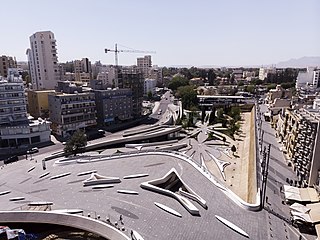
Eleftheria Square ; literally meaning Liberty Square, is the main square in central Nicosia, the capital city of Cyprus, in Europe. It forms the intersection of Ledra and Onasagorou streets with Stasinou, Omirou, Kostaki Pantelidi, Konstandinou Palaiologou and Evagorou avenues. It is considered one of Zaha Hadid's Top 35 projects.

Ledra Street is a major shopping thoroughfare in central Nicosia, Cyprus, which links North Nicosia, the part of the city under the control of the de facto Northern Cyprus, and south Nicosia.

The National Popular Front is a far-right, ultranationalist movement, founded in 2008 in the Republic of Cyprus. It describes its ideology as "popular and social nationalism". As of May 2011, it has been approved as a legal political party. ELAM is a Eurosceptic political party which also praises Greek former prime minister Ioannis Metaxas.
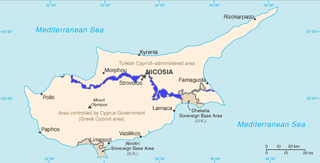
United Nations Security Council Resolution 1687, adopted unanimously on June 15, 2006, after reaffirming all resolutions on the situation in Cyprus, particularly Resolution 1251 (1999), the Council extended the mandate of the United Nations Peacekeeping Force in Cyprus (UNFICYP) for six months until December 15, 2006.

The Occupy movement was an international populist socio-political movement that expressed opposition to social and economic inequality and to the perceived lack of real democracy around the world. It aimed primarily to advance social and economic justice and different forms of democracy. The movement has had many different scopes, since local groups often had different focuses, but its prime concerns included how large corporations control the world in a way that disproportionately benefits a minority, undermines democracy and causes instability.

The 15 October 2011 global protests were part of a series of protests inspired by the Arab Spring, the Icelandic protests, the Portuguese "Geração à Rasca", the Spanish "Indignants", the Greek protests, and the Occupy movement. The protests were launched under the slogan "United for #GlobalChange", to which the slogan "United for Global Democracy" was added by many people's assemblies. The protest was first called for by the Spanish Plataforma ¡Democracia Real YA! in May 2011 and endorsed by people's assemblies across the world. Reasons were varied but mainly targeted growing economic inequality, corporate influence over government and international institutions, and the lack of truly democratic institutions allowing direct public participation at all levels, local to global. Global demonstrations were held on 15 October in more than 950 cities in 82 countries. The date was chosen to coincide with the 5-month anniversary of the first protest in Spain. General assemblies, the social network n-1, mailing lists, Mumble voice chat, open pads such as Pirate Pad and Titan Pad, and Facebook were used to coordinate the events. Some protests were only a few hundred in number, whereas others numbered in the hundreds of thousands, with the largest in Madrid numbering half a million and the second largest city Barcelona with 400,000.

Occupy Movement protests took place in New Zealand, beginning on 15 October 2011 with the Occupation of Auckland. Occupy protests took place in Auckland, New Plymouth, Wellington, Lower Hutt, Christchurch, Dunedin, and Invercargill.
Occupy South Africa was a South African initiative primarily aimed at protesting and inciting mass action against the racial, economic and social inequality in South Africa. It is part of the globally Occupy Wall Street movement. It consists of a loose informal affiliation of on the ground groups and individuals across South Africa as well as internet based groups. Groups such as Taking Back South Africa!, Occupy South Africa are involved in South Africa and online. The movement is also involved with the Marikana miners' strike.

Occupy Sydney was a social movement and protest as part of the global Occupy movements, in Sydney, Australia. The occupation began on 15 October 2011 outside the Reserve Bank of Australia in Martin Place. The Martin Place occupation was first evicted by NSW Police on 23 October 2011. This eviction and later police action was named Operation Goulding. Another eviction attempt occurred on 2 February 2012. The protest site was removed five times in early July 2013, only to re-establish itself each time within hours.
The Occupy movement has been met with a variety of responses from local police departments since its beginning in 2011. According to documents obtained by the Partnership for Civil Justice Fund, the FBI, state and local law enforcement officials treated the movement as a potential criminal and terrorist threat and used fusion centers and counterterrorism agents to investigate and monitor the Occupy movement.

Occupy Minneapolis (OccupyMN) is a grassroots collaboration that began in October 2011 with a series of demonstrations in Minneapolis, Minnesota. Protesters have staged numerous occupations, most notably of the Hennepin County Government Center plaza.
The following is a timeline of the history of the city of Nicosia, Cyprus.
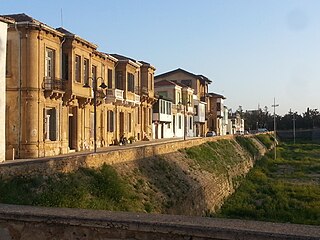
Arab Ahmet is a neighbourhood, quarter, mahalla or parish of Nicosia, Cyprus and the mosque situated therein. Both the quarter and the mosque are named after Arab Ahmet Pasha, one of the Turkish commanders in the Ottoman conquest of Nicosia. It is spelled Arabahmet in Turkish and Άραπ Άχμετ in Greek.
The 2008-2012 Cyprus talks were held as part of the long-going peace process, in order to resolve the Cyprus dispute. The talks failed to achieve their goals. An opinion poll conducted in 2010 reported that 84% of Greek Cypriots and 70% of Turkish Cypriots assumed that: "the other side would never accept the actual compromises and concessions that are needed for a fair and viable settlement". At the beginning of 2013, Cyprus negotiations were suspended because of a change of government in the Greek Cypriot community of Cyprus.

Trypiotis is an historic neighbourhood, quarter, Mahalla, or parish of central Nicosia, Cyprus.











